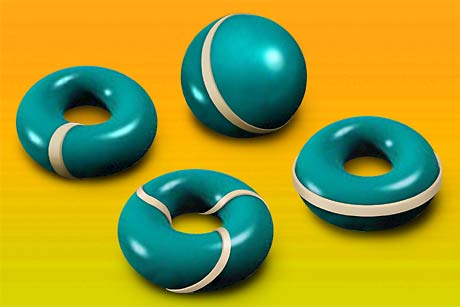Name some of the great footballers alive today. Easy - Pele, Ronaldo, Beckham - most of us can manage that, if not a few more. But can you name three of the great mathematicians alive today? John Nash has recently become a household name thanks to Hollywood, and some might remember that Andrew Wiles proved Fermat's Last Theorem, but after that many of us are stumped.
Now here is another name to add to your list: Jean-Pierre Serre. Serre has just been named as the first winner of the Abel Prize, for "shaping the modern form of many parts of mathematics, including Topology, Algebraic Geometry and Number Theory" (read the past news story on the Abel Prize). Many of the fundamental theorems in these areas are due to Serre, and he has been making significant contributions to mathematics for over fifty years. When he was only 28 he won the Fields Medal (the other mathematics prize of similar prestige to the Nobel), and no one else so young has won the prize since.
The algebraic methods that Serre developed revolutionised Topology. Topology is the study of those features of a space that remain unchanged when it is deformed or stretched. Length isn't one of these, as when you blow up a balloon a line drawn on it will be stretched. However, if you try to find all the ways of drawing closed curves, or circles, on a ball, you will find that there is only one. Any circle you draw on a ball can be stretched over its surface, like a rubber band, to form any other circle you could draw. However, for a doughnut there are more ways to draw different circles on the surface that can't be stretched or pulled to look the same.

The surface of a doughnut is not the same as a ball. There is only one type of closed curve on the surface of a ball, whereas there are many different closed curves on the surface of a doughnut, including the three shown here.
You can often distinguish topologically between two spaces, like the surfaces of a ball or a doughnut, by seeing how many different closed curves they contain. Serre developed an algebraic method of counting the number of ways to put higher dimensional versions of circles in certain spaces, enabling a wide range of topological questions to be tackled.
Algebraic methods also allowed Serre to make significant contributions to Algebraic Geometry. The link between algebra and geometry is something many of us have already experienced in school. Two non-parallel lines on the Euclidean plane intersect at one point, representing the single solution to the system of two linear equations describing the lines. Serre developed the algebraic methods necessary to determine when complicated geometric constructions can be used to solve systems of polynomial equations.
While Serre's work in Number Theory is connected in many ways to the mathematical ideas of Niels Henrik Abel, the Norwegian mathematician honoured by the Abel Prize, it is also relevant to current research. His work in this area has helped to set the stage for many recent results, including Andrew Wiles' monumental proof of Fermat's Last Theorem.
Mathematicians welcome the choice of Serre as the first recipient of the Abel Prize. They hope that the creation of such a prestigious prize in mathematics, with a respectable cash reward of over £500,000, will help raise the profile of mathematics in wider society, just as the Nobel Prizes have for Physics, Chemistry and Economics. In creating the prize, the Norwegian government also hoped to stimulate young people's interest in mathematics. Perhaps one day children will have pin-ups of their favourite mathematicians on their bedroom wall, next to their posters of David Beckham.